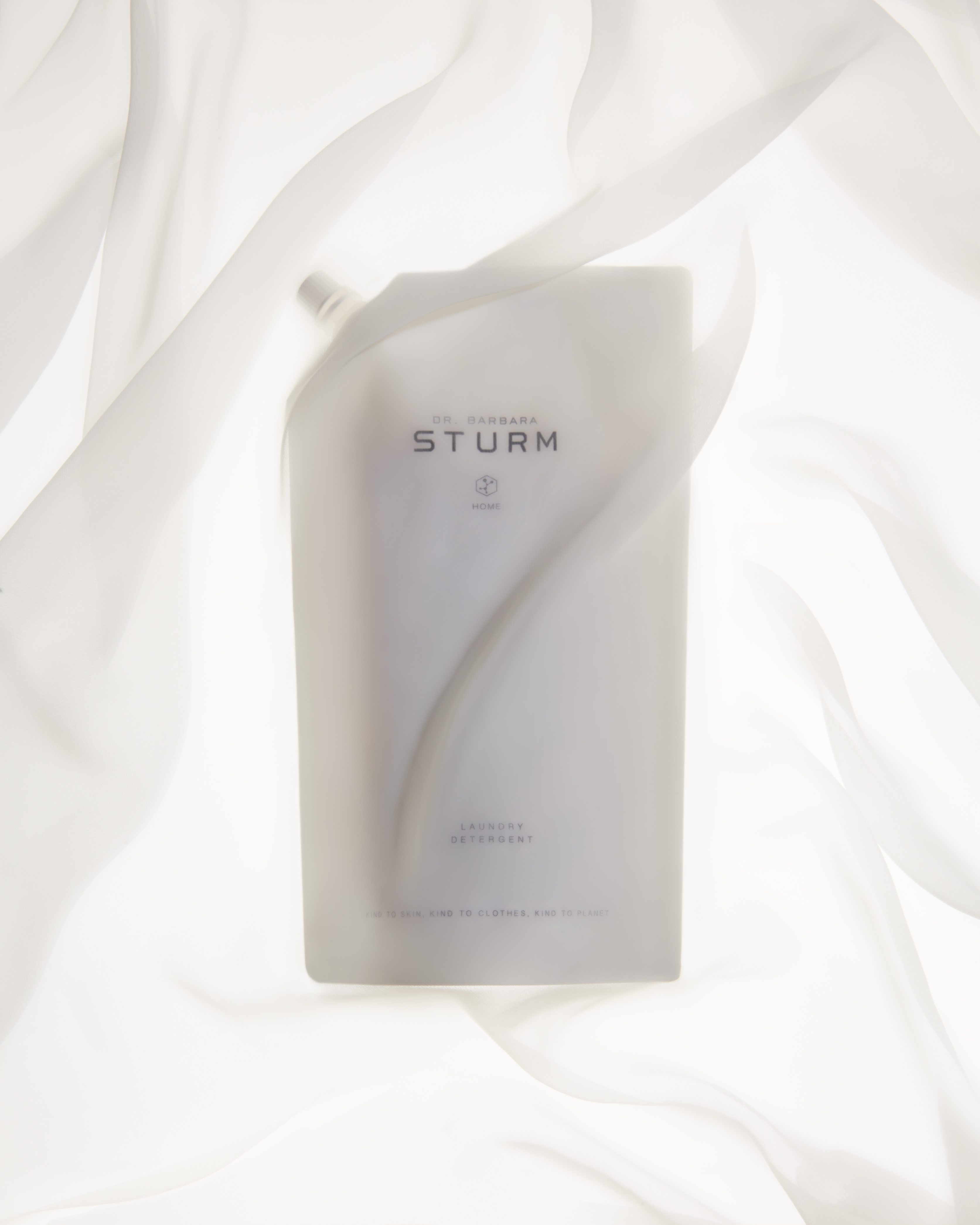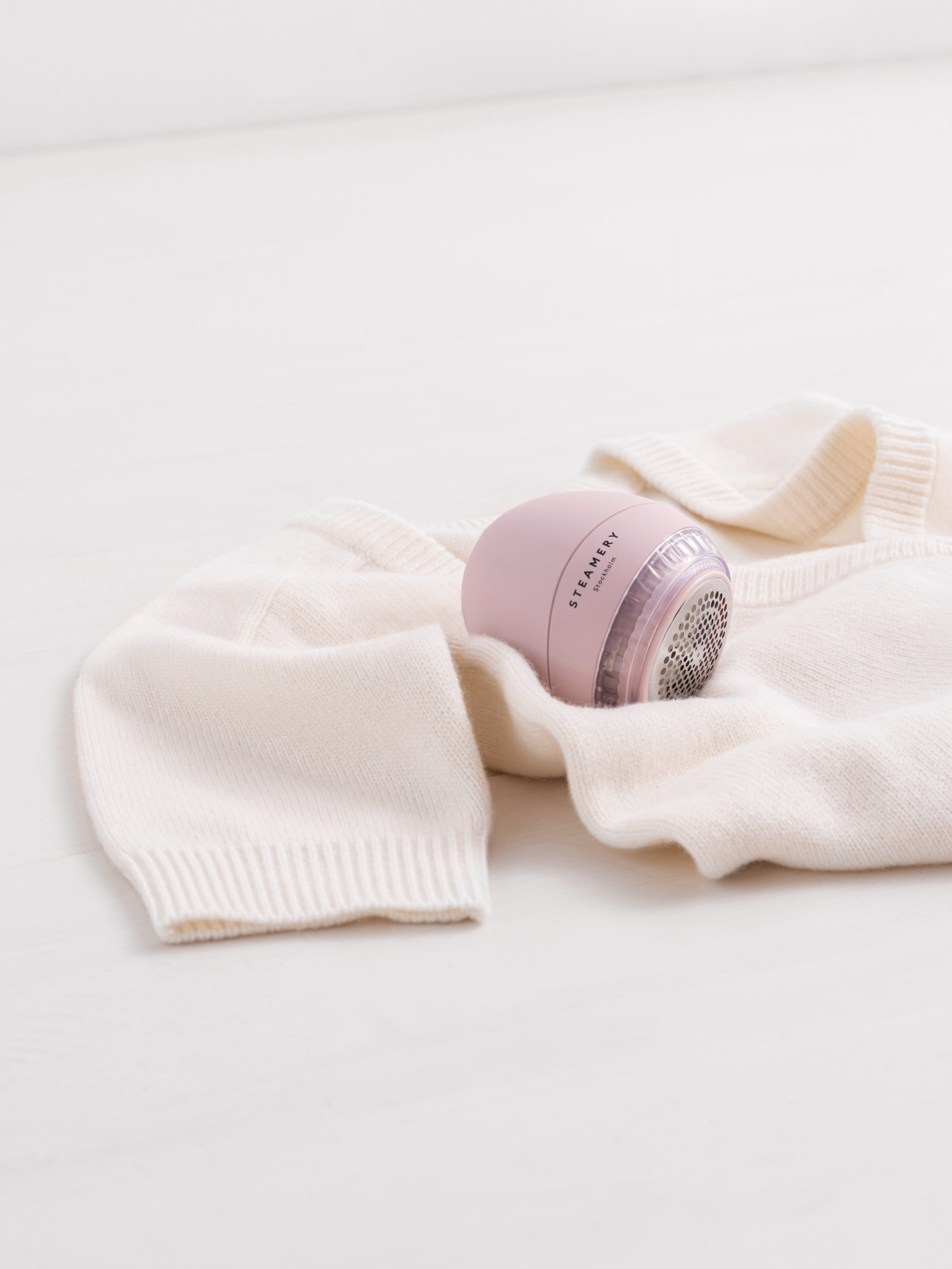
’I think we all need to slow down. Invest in clothes we really need, take good care of them, and hopefully one day pass them along to a new owner,’ says Frej Lewenhaupt, co-founder and CEO of Scandinavian brand Steamery, known for its satisfyingly designed clothing care products – from signature hand-held steamers to an array of fabric shavers, brushes and lint rollers.
It’s a viewpoint that chimes with recent seasons, which have largely seen designers eschew throwaway trends in the pursuit of what has been called ‘discreet luxury’ – the honing of timeless pieces sans logos or monograms, rendered in rich fabrications and made to last long beyond the season’s end. Matthieu Blazy’s tenure at Bottega Veneta has perhaps best epitomised this shift – a pair of trompe l’oeil leather trousers designed to look like a pair of blue denim jeans is the ultimate statement – though an array of other brands have become synonymous with the move towards ‘quiet luxury’, The Row, Loro Piana, Brunello Cucinelli, Max Mara and Celine among them.
Whether these are the brands that hang in your wardrobe or not, it is worth treating all clothing you purchase as an investment. As founder of The Seam – a service which links consumers with a series of ‘makers’ to repair and reinvigorate clothing – Layla Sargent says, this is not just resonant for your personal finances, but the world around you. If clothing stays in use just nine months longer, she says, carbon, water and waste drop by 20 to 30 per cent. Besides, with most fashion trends being cyclical, preserving your wardrobe over years – or even decades – can yield both sartorial and monetary rewards, whether the chance to re-discover a beloved favourite or place it on the burgeoning resale market.
Here, in a definitive guide to clothes care, a group of experts – including Lewenhaupt, Sargent, skincare expert Dr Barbara Sturm (whose recent clothing detergent release sees her bring her anti-inflammatory expertise to the laundry room) and Saskia Dijkstra of Extreme Cashmere, who believes when looked after correctly a cashmere jumper can accompany you for life – give their advice on how to wash, dry, sort, store, repair and refresh your wardrobe so its contents lasts for decades to come.

THE DEFINITIVE GUIDE TO CLOTHES CARE
Launder less
‘Our best advice to make your clothes last longer is to wash them less frequently,’ says Frej Lewenhaupt of Stockholm-based brand Steamery, which includes a number of devices and products that promise to ‘bring the best out of your wardrobe’. ‘Most of the clothes that we put in the laundry basket are barely dirty and might just reveal some smaller traces of being worn for a day or two. Instead of unnecessary washing, you can steam your clothes instead.’
When it does come to washing your clothing, he advises following care-label instructions and selecting the most gentle washing cycle possible (generally, most garments can be washed at 30 degrees Celsius/86 degrees Fahrenheit). ‘If you get a stain on a garment, simply use a stain remover and target the stain directly instead of washing the whole garment,’ Lewenhaupt says.
Sargent of The Seam agrees, suggesting spot cleaning rather than a full wash where you can. ‘Hang clothes to air outside if possible, or in the bathroom if not,’ she says, an alternative to washing which freshens clothing naturally without the necessity for chemical intervention. ‘If you must put clothes in a washing machine, use a low heat, and put delicate fabrics in a laundry bag to reduce tearing.’
Divide and conquer
Most of us divide our clothing between whites and colours, though Lewenhaupt advises being more fastidious – not only dividing more carefully between colours (brights, lights and darks, for example) but also between delicate and more hardy fabrics. ’Not following the care-label instructions is one of the biggest reasons why clothes get washed out quickly,’ he says.
‘When washing your clothes, it’s important to use the right laundry products and techniques to prevent unnecessary wear and tear,’ he continues. ‘Make sure to sort them carefully by colour to prevent colour bleeding and choose a gentle washing cycle on the machine.’ If you really don’t have time to separate, his own colour-absorbing sheets help prevent bleeding and absorb colours shed into the washing machine.
It’s all in the detergent
‘Your average washing detergent contains dyes, fragrances, and bacteria-killing chemicals that can be very harsh on the skin, causing anything from mild allergic reactions to contact dermatitis, depending on skin’s sensitivity,’ says Dr Barbara Sturm, who is known for her molecular skincare and supplements developed with anti-inflammatory principles (she believes that inflammation is the main cause of skin ageing and irritation).
Her recently launched laundry detergent – the first product in the Dr Barbara Sturm Home line – provides her own solution, a plant-based formulation that’s free from preservatives, enzymes, microplastics, dyes, brighteners and other irritants, replaced instead with ‘skin-friendly’ actives, including panthenol, aloe vera and purslane. For simplicity, it’s a one-size-fits-all approach; the singular product can be used for everything in your wardrobe, from sportswear and silk.
‘It’s effective on all types of laundry, including your most delicate pieces and it smells amazing – I use it on wool, cashmere and silk from as low as 20 Celsius / 68 degrees Fahrenheit,’ she tells Wallpaper*. ‘Clean clothes shouldn't come at the expense of your overall health and wellbeing.’
Steamery, meanwhile, offers a more comprehensive range of detergents – including specific formulations for whites, delicates, hypoallergenic, dark and denim and odour control, for sportswear.

Know your fabrics (and dry with care)
All fabrics are different – and should be washed accordingly. For example, cotton is a hardier fabric and can withstand multiple washes, whereas fabrics like silk should be hand washed in cool water using gentle, enzyme-free washing detergents. Washing wool should be avoided – it can generally be freshened by hanging up outside – the same with denim, which can lose shape and colour if washed too often (if you do need to wash jeans, wash cold and on a gentle cycle). If in doubt, consult Steamery’s comprehensive fabric glossary.
Saskia Dijkstra of Amsterdam-based label Extreme Cashmere (available from matchesfashion.com and extreme-cashmere.com) is evangelical about fabric care, particularly cashmere, a fabric that she says is often misunderstood. ‘A common misconception is that cashmere cannot be safely washed in a machine, but all our cashmere garments are machine washable – cashmere loves water,’ she says. ‘We advise you to wash your sweater after wearing it two or three times in a high-quality machine on a cool wool program.’
‘After washing, dry the garment lying flat on a towel as it prevents the garment from stretching out. Ironing at a low temperature will help ease the fibres and get them back into place. And lastly, you can remove excess pilling by using a cashmere comb. With the right care, you can enjoy your favourite cashmere sweater for life.’
The tumble dryer should largely be avoided, says Lewenhaupt. ‘When drying your clothes, we recommend not tumble drying anything except bed linen and towels. The gentlest way to dry your clothes is to let them air dry.’
Full steam ahead
Steaming, says Lewenhaupt, can be a gentler way to get the creases out of your clothing – while irons tend to compress fabric, ’steaming lifts and makes the textile fibres swell instead of pressing them, which allows them to regain their natural shape.’ As such, Steamery offers an array of steamers, from their hand-held Cirrus range (perfect for travel), stand-up Cumulus home steamer, or the professional Stratus steamer.
‘Steaming also allows you to de-wrinkle delicate fabrics like silk, as well as garments that cannot be ironed due to their shape or texture, like draped, pleated, or beaded items of clothing,’ he continues. Steaming also kills bacteria, keeping clothes smelling clean. ‘Our best advice for keeping your clothes fresh is to air them outside occasionally and steam them regularly to make them wrinkle-free and smooth. Finish off with a spritz of scented fabric spray and your clothes will be ready to wear again.’

Store seasonally
The way you store your clothes is essential, says Sargent, who with The Seam has previously collaborated with Net-a-Porter and COS. ‘Firstly, get rid of any clothes that you don’t use and free up space for the stuff you really care about. Wash, dry, repair and de-bobble all of your clothes before you store them – by doing so, you will feel very excited to finally retrieve them from storage instead of being faced with lots of work to do before you can wear something again,’ she says. When getting rid of clothing, look towards circular retail platforms like Vestiaire Collective, Hardly Ever Worn It, or Grailed, which give your garment a second life in somebody else’s wardrobe (some platforms will even pick up from your front door).
‘Vacuum storage bags are a popular go-to – however, items made from natural fibres such as wool and silk will fare much better in plastic storage boxes,’ Sargent continues. ‘To try and prevent moths reaching your items, use storage boxes with sealed lids and if you really want to go the extra mile give your clothes a good airing every six to eight weeks and use it as an opportunity to check for any rogue moths that may have somehow entered.’
Lewenhaupt adds that it’s best to keep your wardrobe seasonal. ‘Fill your closet only with garments that fit the current weather and sort out all the clothes that you no longer need or that do not fit quite right,’ he says. ‘When you bring out garments for the coming season, simply use a steamer to freshen up your clothes and smooth out creases. Donate or sell the items that you are not keeping so that someone else can enjoy them.’
Repair, repair, repair
The tradition of repairing clothes has largely been forgotten, though Sargent – who started The Seam after feeling like tailoring was divided between high street dry cleaners and Savile Row, with nothing in between – says that mending clothing is a surefire way to make clothing last. It is also a way to reduce your environmental footprint: ‘if clothes stayed in active use for nine months longer, extending their average life to around three years, this would reduce their carbon, water and waste footprints by 20 to 30 per cent,’ she says.
Some repairs, she says, can be easily done at home – from replacing buttons (if you can't find a matching button, she says, instead replace the full set) to de-bobbling garments using combs of machines. Steamery offer two fabric shavers: ’pilling is when small pills or bobbles appear on knitted and woven fabrics, and it is a common reason why many garments are returned or thrown away,’ says Lewenhaupt. ’By simply shaving off the bobbles with a fabric shaver, your textiles will appear as new again.’
Head to a professional for discreet, invisible, or more complex repairs – particularly when it comes to delicate fabrics, adds Sargent. ‘Some fabrics require more specialist skills than others. To name but a few: silk, satin, wool, jersey, denim,’ she says, noting that The Seam offers a web chat service which will connect your query with a relevant ‘maker’ – whether a tailor, seamstress, cobbler, embroidery artist or one of the many other artisans in The Seam community.
As for what to look out for on your own clothing, she says The Seam’s most common booked repairs are for ‘holes in woollen items; damage to shoes and bags; sneaker restoration and denim repairs. Restoration of leather items is also very common, sometimes a deep clean and specialist service using leather balms can take years of wear off an item, great if you’re looking to keep it yourself and wear it for longer, or looking to resell it.’

steamery.co.uk
www.theseam.uk
drsturm.com
extreme-cashmere.com







